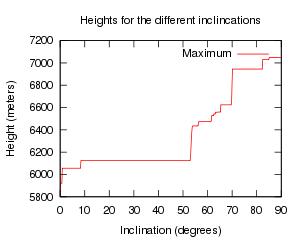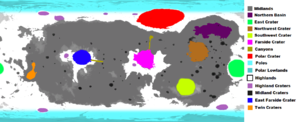Difference between revisions of "Mun"
m |
m (Added picture) |
||
| Line 63: | Line 63: | ||
File:Isa_mapsat_mun_map800.gif|A topografic height map of the mun made with the ISA MapSat plugin | File:Isa_mapsat_mun_map800.gif|A topografic height map of the mun made with the ISA MapSat plugin | ||
File:screenshot1.png | A successful landing on the Mun with a two-kerbal capsule. This is often a milestone for new players. | File:screenshot1.png | A successful landing on the Mun with a two-kerbal capsule. This is often a milestone for new players. | ||
| + | File:0.21 Kerbal Staring Sun From Moon --Copyright by Squad--.jpg| A kerbal watching the sunrise on the moon, should we be worried he's not blinking? | ||
File:Kerbals on moon.png | Two Kerbals standing on Mun's surface with the flag of the United States. | File:Kerbals on moon.png | Two Kerbals standing on Mun's surface with the flag of the United States. | ||
File:A Kerbal on the Mun.jpeg | A Kerbal on the Mun with his ship, flag, and Kerbin in the background. | File:A Kerbal on the Mun.jpeg | A Kerbal on the Mun with his ship, flag, and Kerbin in the background. | ||
Revision as of 14:02, 28 November 2013
Mun, also known as the Mun and sometimes written as Mün, is a relatively larger moon orbiting Kerbin. It can be thought of as an analogue to our own Moon. It is gray in appearance with craters of various sizes and mountains exceeding 5029 m in height. The gravitational pull on the surface is 1.63 m/s², approximately 1/6 and 8.18 m/s² lower than that of Kerbin and about the surface gravity of Earth's Moon (1.624 m/s²). It is possible to land on the Mun or use it for gravity assist (gravitational slingshots) to outer bodies such as Minmus or into Kerbol orbit, though such maneuvers do not save very much fuel and are more imprecise. It is, however, useful for plane changes with proper timing.
New players should note that Mun (like the majority of celestial bodies in the game) has no atmosphere. That means parachutes do not work when descending to the surface.
There are anomalous geological formations that can be found on the surface of the Mun. To preserve the enjoyment of exploration for new players, those who have found these sites are encouraged to keep their exact coordinates secret.
Synchronous orbit around the Mun is not possible, since it would have to occur at an altitude of 2 970.58 km, beyond the Mun's sphere of influence. However, putting your spacecraft just outside Mun's SOI and having the same semi-major axis would make it appear stationary. A normal 25 km orbit can be achieved using around 800 m/s delta V. A semi-synchronous orbit with half the rotation period of the Mun is possible at approximately 1797.41 kilometers.
Contents
Terrain
The Mun's terrain is rough, grey, and scarred by craters. Its low-lying areas tend to be darker in color. The Mun also features canyons which can be hundreds of meters deep and a few kilometers long.
The Mun's highest points reach a maximum altitude of more than 7061 m near the south pole at 152.33° W and 82.52° S. This altitude permits 10× warp, allowing crashes with terrain while being in a seemingly stable orbit. Its lowest point, below -247 m, is on the northern hemisphere south-west of the large northern crater at 76.63° W and 35.32° N.
When terrain scatter is activated in the graphics settings, the Mun has rocks scattered on its surface. Like all terrain scatters, these rocks are strictly cosmetic and do not collide with ships or Kerbals.
As of 0.21 the Mun is peppered with procedural impact craters making Mun landing more difficult. Previously the lowest point with an altitude of 0 m was on the east side of a large crater, at 35.42° E, 8.27° N.
The Mun also has several hidden surprises for explorers to find:
- There are three large stone arches. Due to their size they can be spotted easily from a low (<10km) orbit near the equator.
- There is a memorial honoring Neil Armstrong, the first man on the moon. It can be found inside one of the largest craters, near the south wall. It is at nearly the same coordinates where Apollo 11 first landed on the moon. It appears as a tiny white dot from low orbit.
- There are three monoliths ("Munoliths"). These are very hard to find because of their small size. One is underground, and two are floating inside of two extremely deep pits that go almost straight down.
- There are several other secrets on the Mun for the dedicated observer. Look around!
Biomes
Currently[outdated] Mun is the only celestial body besides Kerbin which has multiple biomes in or over which science experiments deliver different results. It has even more biomes than Kerbin. Each of the large craters is an individual biome. Then there are midlands- and highlands, which both return different results when inside/over one of the minor craters. The polar regions also have three different biomes. With the biomes the major craters have somewhat official names, although the names appear to be very generic. The complete list of Mun biomes is:
- Midlands
- Midland Craters
- Highlands
- Highland Craters
- Canyons
- Nothern Basin
- East Crater
- Northwest Crater
- Southwest Crater
- Farside Crater
- Twin Craters
- East Farside Craters
- Polar Crater
- Poles
- Polar Lowlands
Observation of Kerbin
The Mun's orbit keeps it directly above Kerbin's equator. Because the Mun is tidally locked to Kerbin with a perfectly circular, non-inclined orbit, exactly 50% of the Mun's surface (excluding areas on the edge obscured by the Mun's mountains) is ever visible from Kerbin. This also means that Kerbin is only visible from this same 50% of the Mun's surface, and that Kerbin never sets or rises as seen from the Mun. The Mun longitude for which Kerbin remains directly above in the sky (at the zenith) is about 47 degrees east. The Mun's equator is coplanar with Kerbin's, so any location on the Mun's equator that faces Kerbin will also face Kerbin's equator. Kerbin is not tidally locked to the Mun, so any point on the Mun where Kerbin is not obscured by the Mun's landscape will be able to observe every point on Kerbin as Kerbin rotates. Kerbin's synodic rotational period with the Mun is 25617.909 seconds, or 1.18323 Kerbin solar days. Due to the Mun's non-inclined orbit, solar eclipses occur every time the Mun goes between the Sun and Kerbin. Due to engine limitations, these solar eclipses currently do not make the sky black, or darken the land. However, solar panels will become blocked by the Mun in an eclipse and become useless for a short period of time.
Reference Frames
Gallery
- Screenshot1.png
A successful landing on the Mun with a two-kerbal capsule. This is often a milestone for new players.
Trivia
- Prior to version 0.14.2, the tallest points on the munar surface were no higher than roughly 600m.
- Mun was Kerbin's, and indeed the game's, very first moon.
- After its implementation, many fans began calling the body Mün, pronounced the same as "moon", believing the original spelling to be a mistake. However, several of the game's developers have been heard referring to it as Mun, pronounced "muhn". In the "Surface of the Mün" title screen, a crashed lander resembling a Kerbal X has the words "Mün or Bust" scrawled on the side. Both spellings are generally accepted, however the spelling in-game is Mun.
- Mun's orbit is perfectly circular and has zero orbital inclination. Such an orbit in reality would be very unlikely since this would require precise positioning of any dust/bodies that created it during the planetary system's formation, as well as the absence of a central star or other planets.
- This was likely done to make it easier to reach for new players.
- Before introduction of procedural terrain the Mun's highest point was within 45° latitude of the equator, had an altitude of 2967 m and was located at 129.64° W, 0.97° N, on the north side of a canyon which was on the east edge of a large crater.
Changes
- New Procedurally generated craters.
- Height values reverted
- Terrain overhaul
- Easter Eggs added (one fixed, one added)
- New small art pass.
- Texture Improvements
- Easter Eggs added
- Texture Improvements
- Terrain overhaul
- Initial Release
Notes














